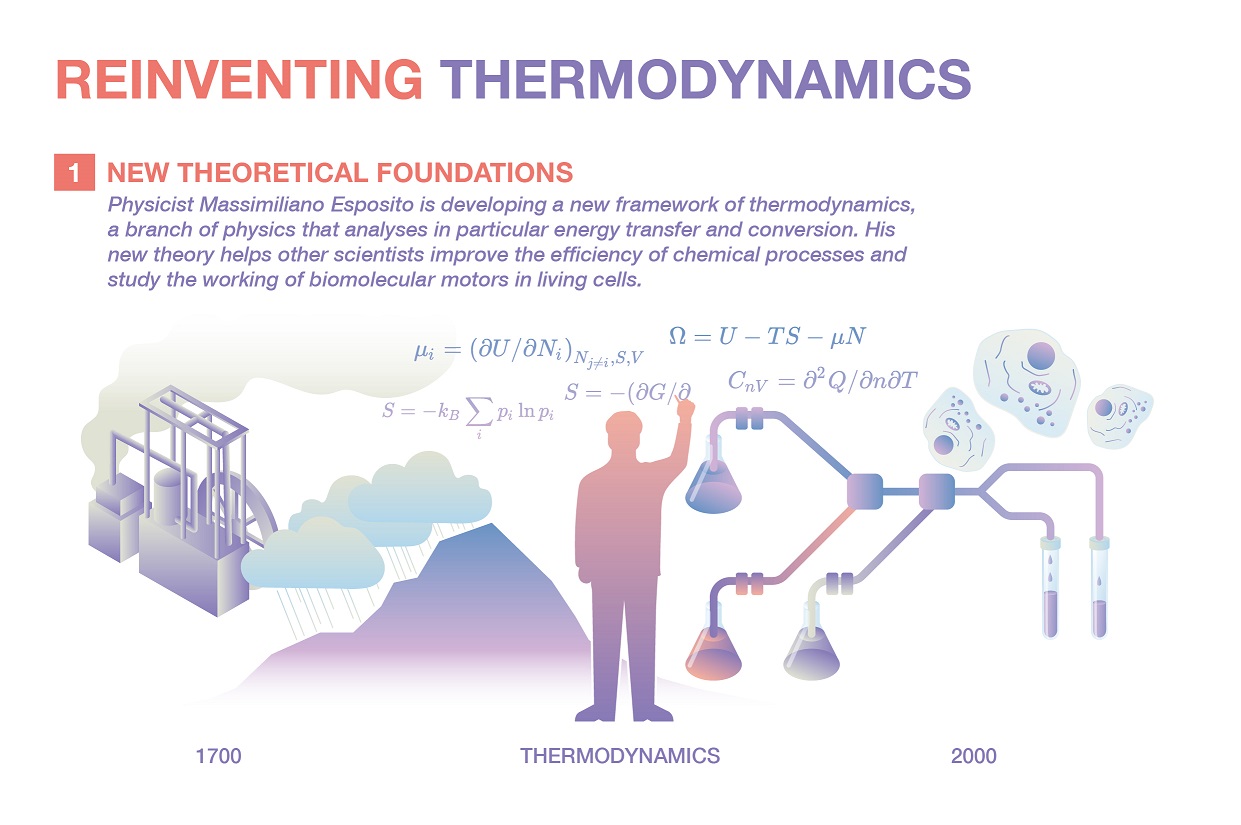
A physicist has developed a new theory of thermodynamics to describe the microscopic world. It explains the astonishing efficiency of biological motors in our cells, improves the efficiency of chemical reactions and reveals the concrete role played by this abstract concept: information.
At the beginning of the 19th century, steam engines began to move trains and industrial power machines. Thermodynamics at that time developed theoretical tools to analyse their energy balance and improve their efficiency. Two centuries later, a physicist from the University of Luxembourg invented novel thermodynamics to study microscopic phenomena. His work and the contributions of researchers from all over the world have led to a better understanding of fundamental biological, chemical and electronic phenomena, and to the imagination of how to push back the limits of their efficiency.
Efficiency and power, simultaneously
Massimiliano Esposito has discovered a surprising principle: while it is impossible to maximise the efficiency of an engine and its power simultaneously, as motorists are well aware, it is possible to achieve the equivalent in chemical reactions.
“Traditional chemistry normally proceeds rather slowly,” explains the researcher. “Just as in cooking, ingredients are added to containers, mixed, cooked and then left to set. But it can be done differently, by bringing in constant flows of reagents through tubes. This results in rapid reactions.”
Esposito analysed these chemical reactions as thermal machines and showed that it is indeed possible to produce molecules both abundantly and efficiently – an impossible optimum in conventional thermodynamics.
The secret is to work in a different regime. Standard thermodynamics is normally concerned with situations close to equilibrium or a stationary regime characterised by slow and constant flows. Massimiliano Esposito, on the other hand, has developed a theory of out-of-equilibrium thermodynamics: it describes abrupt changes, and in these conditions, it enables to go beyond the usual limits of efficiency.
Exploring such a regimen naturally leads to the microscopic world, because the smaller the system, the faster and stronger it reacts: the air in the centre of a balloon, for example, is protected from external influences by numerous layers of air. On the contrary, a molecule constituting a nanoparticle is very close to the surface and participates fully in the reactions.



Cellular railway
Equipped with the concepts he has been developing for the last ten years, Massimiliano Esposito tackles a wide variety of problems. Recently, he has been studying the astonishing efficiency of kinesins, molecular motors charged with transporting biochemical structures inside living cells. Like locomotives, these proteins move along microtubules – filaments acting as rails – towing their cargo behind them.
His work suggests that collective effects may explain the efficiency of these phenomena essential to life. Using simplified models, he has shown that the efficiency of these motors increases tenfold when they operate in a synchronised fashion, like rowing machines. The total power is then far greater than the sum of the individual motor powers.
Confronting a demon
His concepts have also made it possible to elucidate a famous mystery – or paradox – of physics: Maxwell’s Demon, an imaginary devil who would sort gas particles according to their speed in order to cool a gas without consuming energy, in flagrant contradiction with the second law of thermodynamics. One of his articles inspired a Finnish team to build a real Demon based on a pair of tiny electronic structures called quantum dots. In this experiment, the first quantum dot plays the role of the demon: it influences the number of electrons trapped in the second without expending any energy. In doing so, it cools its environment, as if a river were beginning to flow back towards its higher source.
This sacrilegious experiment roughs up the laws of thermodynamics, explains the physicist, but it does not contravene them. However, it is crucial to take into account not only energy balances but also information transfers, because information is not free and has an energy cost that can be quantified. These considerations are not just imaginary demons but are at the basis of information theory, which is crucial in computing and telecommunications.
The importance of solid foundations
Like thermodynamics in its early days, Massimiliano Esposito’s work is very theoretical. But they are often taken up by scientists who tackle concrete problems: biologists studying cells, chemists seeking to optimise reactions, or engineers making devices to generate electricity in satellites thanks to the temperature differences in space.
“The aim of my work is to develop a solid and reliable theoretical basis that is useful to other specialists. But I also want to encourage links between physicists, biologists and engineers. The solutions developed by nature are often extremely effective. It is up to us to understand why.”
About the European Research Council (ERC)
 The European Research Council, set up by the EU in 2007, is the premiere European funding organisation for excellent frontier research. Every year, it selects and funds the very best, creative researchers of any nationality and age, to run projects based in Europe. The ERC offers four core grant schemes: Starting, Consolidator, Advanced and Synergy Grants. With its additional Proof of Concept grant scheme, the ERC helps grantees to bridge the gap between grantees’ pioneering research and early phases of its commercialisation. https://erc.europa.eu
The European Research Council, set up by the EU in 2007, is the premiere European funding organisation for excellent frontier research. Every year, it selects and funds the very best, creative researchers of any nationality and age, to run projects based in Europe. The ERC offers four core grant schemes: Starting, Consolidator, Advanced and Synergy Grants. With its additional Proof of Concept grant scheme, the ERC helps grantees to bridge the gap between grantees’ pioneering research and early phases of its commercialisation. https://erc.europa.eu
More about Massimiliano Esposito & thermodynamics
More features in this series
The ERC series is written by Daniel Saraga. The purpose of this ERC series is to showcase the high quality of research in Luxembourg, and how it is also attracting prestigious international funding.













